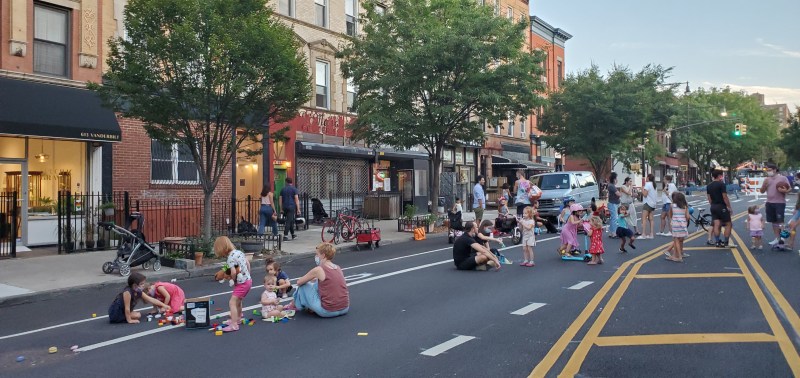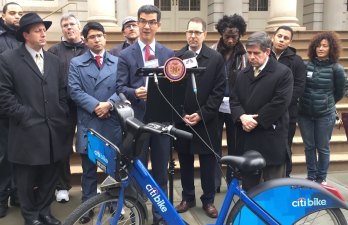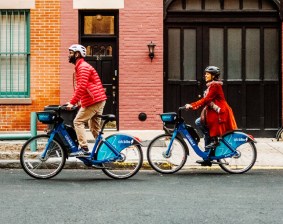OPINION: Citi Bike’s Lessons for Open Streets
Mayor de Blasio — who has it much easier than his predecessor when it comes to urban amenities — should follow the bike-share playbook.

It is hard to watch the complaints about the North Brooklyn Open Streets program and not hear familiar echoes of the controversy over Citi Bike when it launched in 2013. Back then, angry residents vandalized bike-share stations. Some said the program was not for “real” New Yorkers, who depend on cars. Others believed bike-share docks would adversely affect emergency-response times. Fears that senior citizens would be trapped in their homes, unable to walk their dogs or get groceries, were common. Restaurant owners were upset. Lawsuits were filed. Neighbors yelled at their neighbors. Such conflicts didn’t lead to physical assaults, as we saw last week along Driggs Avenue, but they weren’t good.

Today, no one needs to go into much detail about how wrong many people were about New Yorkers’ appetite for bicycle sharing. Chances are it won’t take long for the same to be said about the much smaller, but undeniably vociferous, chorus of people complaining about open streets.
The Citi Bike rollout, moreover, can teach this administration some lessons about how to create a successful open streets program. Chief among them is, “Go big or go home.”
Mayor de Blasio has the political capital to do it.
When it comes to bike lanes, bicycle sharing, pedestrian plazas, bus lanes and people-friendly streets in general, the de Blasio administration is operating in a cultural and political environment the previous administration could only have dreamed of, one that should cause the mayor to not just stick with the existing open streets but rapidly fund, expand and make permanent a broader and more equitable version of the program that can be sustained well into the future. Ironically, it could be the most positive, enduring and climate-friendly legacy of a man about to leave office with accomplishments ranging from universal pre-K to a record streak of days he was driven to the gym.

Consider how easy the mayor would have it if he opted to expand open streets compared to the obstacles faced by the Bloomberg administration when it launched Citi Bike. In 2013, the concept of renting bicycles for short A-to-B trips was largely unknown among a great number of New Yorkers. Planners, politicians and advocates had to spend a lot of time and energy answering basic questions about what bike sharing was and how it would work.
That’s not a factor with the open streets program. New Yorkers are familiar with Times Square, Fowler Square, Diversity Plaza and plenty of other places where cars have been tamed. Even setting those plazas aside, images of people dancing on open streets on 34th Avenue in Jackson Heights or picnicking on the median of Vanderbilt Avenue in Prospect Heights are helping New Yorkers imagine a better way of using their streets no matter where they live. Just as neighborhoods that once resisted Citi Bike now wonder when they will get their first stations, many communities soon will start asking, “When do we get our open street?”
The media landscape also has changed. News outlets that once fed at the bikelash trough for clicks are now staffed by smart reporters — some of them Streetsblog alums — who cover these issues fairly, understand livable streets policy at a high level, and are more likely to arrive at assignments by bike or transit than by car. Such a change is best illustrated by Mayor Bloomberg’s performance at the 2013 Citi Bike launch event, at which he swatted down more than a few questions from journalists who clearly identified with aggrieved drivers. Today, few reporters go along with the idea that a program is controversial just because a few car owners complain about having to circle the block for parking.
Here’s how de Blasio can capitalize on Citi Bike’s lessons: Citi Bike was launched with 332 stations and 6,000 bikes, numbers large enough that helped it overcome some initial hiccups and become an integral part of the city’s transportation network. Sadly, the open street program has been implemented in fits and starts, with version 1.0 woefully over-policed and seemingly designed to attract as few people as possible. There have been some notable upgrades in version 2.0, but too many open streets remain disconnected from each other and important destinations, making it easy for opponents to claim that certain locations don’t make sense or provide real help to people who need to get around safely. (And many open streets have simply disappeared from the map.)

Just as bike-share riders benefit from a networked system that never shuts down, the best version of an open streets program is also one that’s connected and in effect 24/7. Such predictability benefits drivers, too, because it minimizes confusion. Taking another page from Citi Bike, clear signage and robust barriers are key, as one secret to the bike-share system’s success is that it’s very usual for anyone to lift a Citi Bike share station and put it in the back of a van.
There’s one final, and rather obvious, lesson from Citi Bike: It takes money and paid employees to operate. The necessity of relying on corporate sponsorship and private ownership is a discussion for another day and something that would likely not be the same if the system were launched today, but Citi Bike does not require volunteers to pump tires, rebalance bikes, sweep trash from between docks or risk verbal or physical abuse at the hands of angry motorists. City streets are city assets and changes to them, as well as their ongoing upkeep, should be funded with city dollars. We don’t expect drivers to start a GoFundMe campaign to fix potholes.
None of the above is to argue that open streets should be installed in neighborhoods without thought or consideration. Much as how bike-share stations still get moved now and then at the request of a community board or business owner, the open streets program can be tweaked to ensure it works well for everyone. We can rest assured that the hardworking members of the Department of Transportation are well aware of what it would take to make such a program not just a success but the envy of cities across the country.
It’s also important to acknowledge that, compared to the nearly citywide freakout over Citi Bike in 2013, today it’s really just a few cranks displeased by a small subset of open streets. Huge numbers of New Yorkers agree: open streets are immensely popular, and they are ready for more. Does the mayor understand how easy he’s got it?
Doug Gordon is a Brooklyn-based street-safety activist, media producer and co-host of “The War on Cars” podcast. Follow him on Twitter @brooklynspoke.


